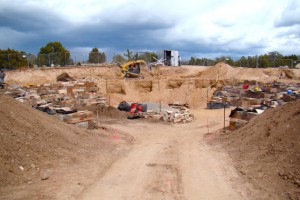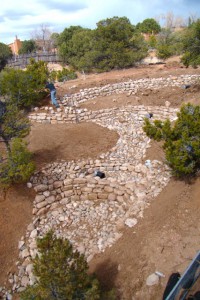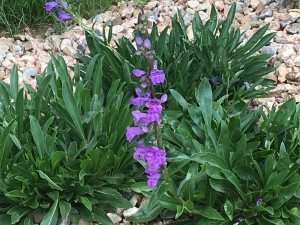By Donita L. Frazier, DVM, PhD

Creating the hardscape for Ojos y Manos Garden during winter 2016. Photo: Clayton Bass
Cold winter mornings are the perfect times to dream about new garden projects. Hardscape projects and landscape cleanup are still possible in early winter when planting is no longer feasible. Recent catastrophic fires should inspire us to consider new projects that involve firescaping. It is particularly important in locations where our properties merge with forest land, but having a defensible space that enhances the property is also important in urban areas.
An increasing number of cities in the arid West are initiating building codes that decrease fire risk, such as siding and roofing with low flammability and driveways that are wide enough for fire-trucks. Firefighters may be forced to abandon structures that are not defensible because of inaccessibility or risk to firefighters. No plant is fire-proof. All will burn in intense fires, but some are more resistant than others. Knowing which to plant and where to plant them, combined with practical hardscape design, can make a significant contribution toward survival.
In wildfires, most houses are ignited by sparks, which can be blown a mile or more. The goal of firescaping is to surround our houses with things that are less likely to be ignited by sparks and to slow or limit burning when they do ignite. Prevailing winds, seasonal weather, and characteristics of native vegetation in the surrounding area should be considered. During our summer fire season in Santa Fe, the prevailing winds are from the southwest. Location of a house on a southwest slope above a brushy area requires more careful landscape planning than one located on a flat lot. Winds are often from the north in winter, making pruning of fire-prone dormant vegetation particularly important on the north side of our houses. Unless your home is in a mountain community with a history of recurrent wildfires, it may not be prudent to tear out all native plants immediately surrounding the house.

Wooly speedwell along paths. Photo: Cristina Salvador
Our native plants are tolerant of periodic drought and most are less hazardous than weedy invasive species such as cheat grass (Bromus tectorum) or kochia (Bassia scoparia). Our native plants help control water runoff and erosion, keep our homes cool in summer, and protect from strong winds throughout the year. However, prolonged droughts mean we must continually monitor and remove dead vegetation from our properties. Weedy vegetation should be replaced. And whenever we add new plants or hardscape, we should have the goal of making our properties more fire-resilient.
Creative hardscaping can make our homes and gardens more attractive and can be important fuel breaks that stop or slow the spread of fire. This includes driveways, walkways, and patios made of inorganic materials. Wood decks should be avoided. Boulders, rocks and gravel mulches are protective, but organic mulches can also be used as long as they are not highly flammable materials such as bark or pine needles. Ponds, water features, or meandering dry streambeds filled with rocks make good firebreaks. Rock or concrete retaining walls impede fire movement up steep slopes. Although coyote fences are one of the things that characterize our communities, it is better to use walls of stone, adobe or concrete adjacent to our houses. Wooden fences should never be used to screen propane tanks.

Photo: Clayton Bass
The 30 feet closest to a structure is the most critical defensive space. Conifer shrubs and trees should be minimal in this area because they contain resins, oils and waxes that burn intensely. Deciduous trees generally do not contain flammable oils and have a lower fuel volume when dormant; therefore, are generally more fire resistant. Although trees such as cottonwoods and aspen do not burn well, the leaves they drop in autumn are highly flammable and should be removed if near houses. Ideally, tree limbs should be kept at least 15 feet from structures and power lines, and lower limbs should be removed. Firewood should never be stacked in this area.
Ice-plants and other succulents are good choices for the areas immediately around the house. Drought-tolerant perennials, such as penstemons (Penstemon spp.), evening primrose (Oenothera spp.), gazanias (Gazania spp.), yarrows (Achillea spp.), thyme (Thymus spp.), sedum (Sedum spp.), lamb’s ears (Stachys byzantina), deadnettle (Lamium spp.), partridge feather (Tanacetum densum subsp. amani), and low growing drought-tolerant grasses, such as buffalo grass (Bouteloua dactyloides), are also good choices. Tall ornamental grasses can be beautiful in autumn and winter, but they are particularly flammable when dormant and should not be planted next to houses. If used in the landscape, they should be cut short in winter if they are near buildings, in areas with a history of fires, or close to driveways or roads where they may be easily ignited.

Rocky Mountain penstemon (Penstemon strictus) Photo by Joan Grabel.
Our gardens and orchards are often located further than 30 feet from the house. In this area, it is good to create “islands” or clusters of plants with space between them. Ideally, trees should be thinned so than crowns are separated by at least 10 feet. Our beloved piñons do not self-prune dead limbs, so pruning may improve their ability to withstand a low intensity fire and limit them from spreading the fire further. Lower limbs should be pruned up to 8-10 feet above ground level for tall trees and up to 1/3 the height of the shorter trees. Fire-resistant shrubs can be planted in this area, including roses, currants, mountain mahogany, sumac, and many others. It is important to prune dead stems from shrubs annually. Pruning removes fuel load and produces a more succulent plant. Shrubs should never be planted under the crowns of trees. Separation between layers of plants – groundcovers, shrubs and trees – eliminates the fuel “ladder” that may carry a low intensity ground fire to the tree canopies, preventing an “out-of-control” fire. Succulent groundcovers are useful for slowing the spread of flames up steep slopes.
Fire-wise landscapes can be beautiful. Choice and spacing of plants, and design and location of hardscapes are critical components. Remember that plants change seasonally and annually and the landscape must be maintained to retain its fire-wise character.
For more information about choosing specific plant species for New Mexico, see New Mexico State University Cooperative Extension Service’s “Fire Wise Plant Materials”:
http://www.emnrd.state.nm.us/SFD/FireMgt/documents/FireWisePlantMaterialsNMSU.pdf
*Donita L. Frazier, DVM, PhD is a life long avid gardener and Santa Fe Botanical Garden Volunteer. Her volunteer activities include working on plant collections projects including the IrisBG plant database and Garden Explorer.
Questions or requests for article, please contact Collections Manager, Cristina Salvador ([email protected]).


